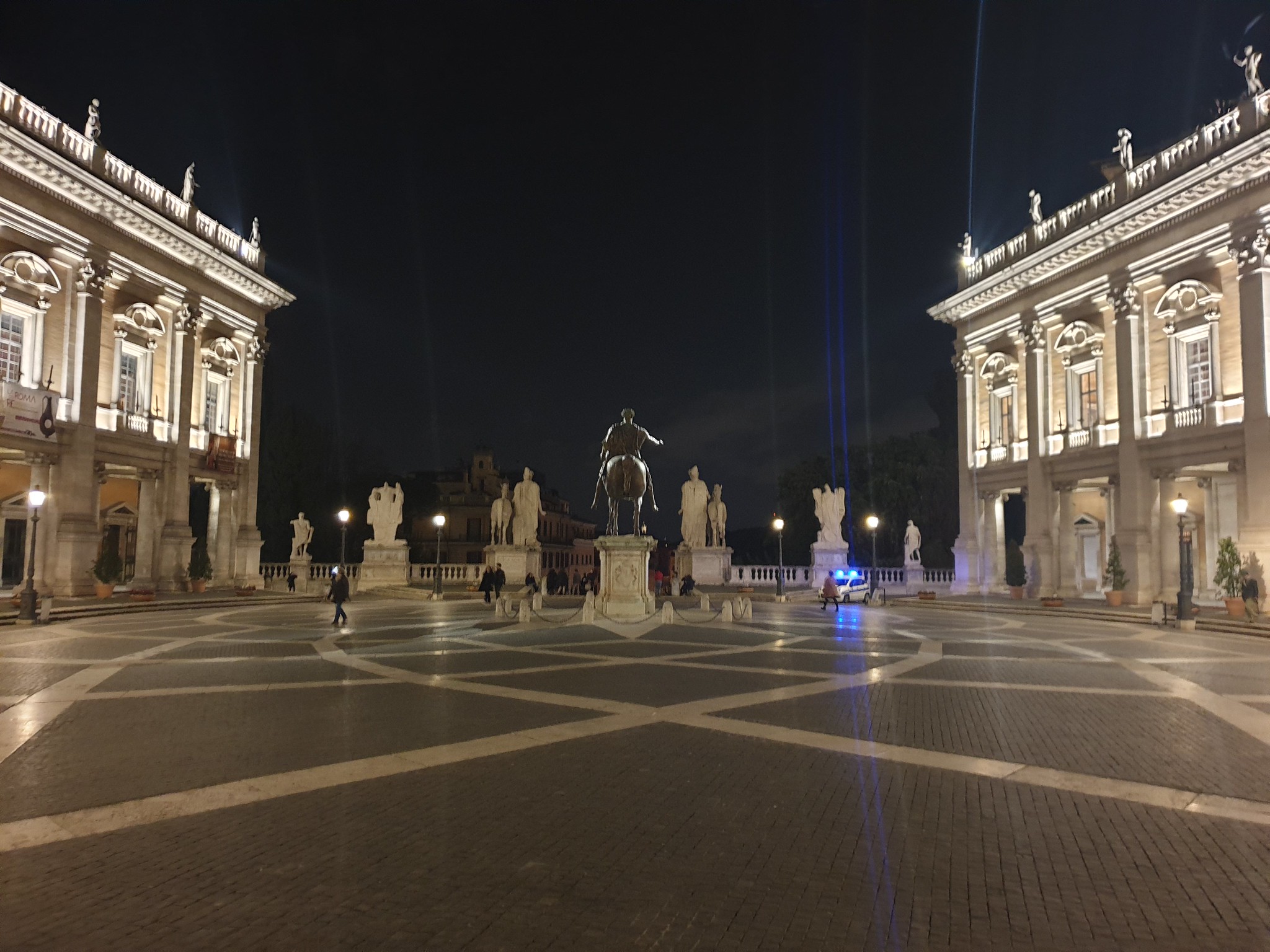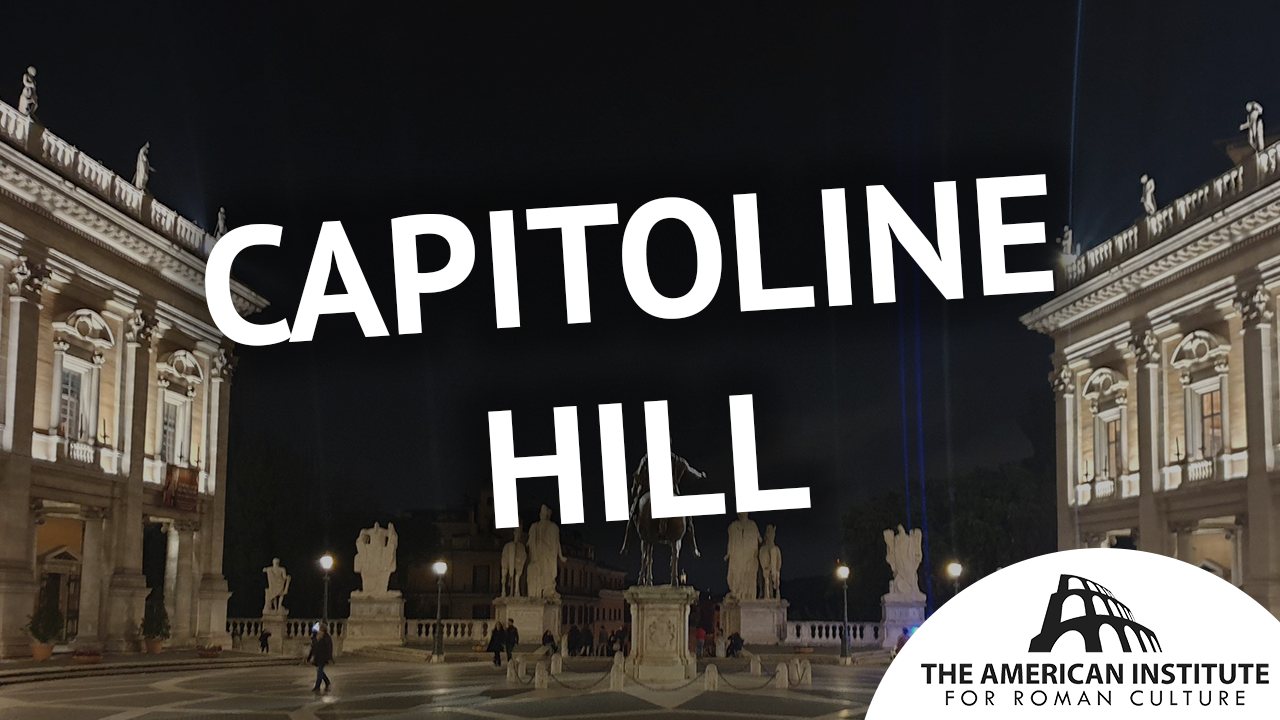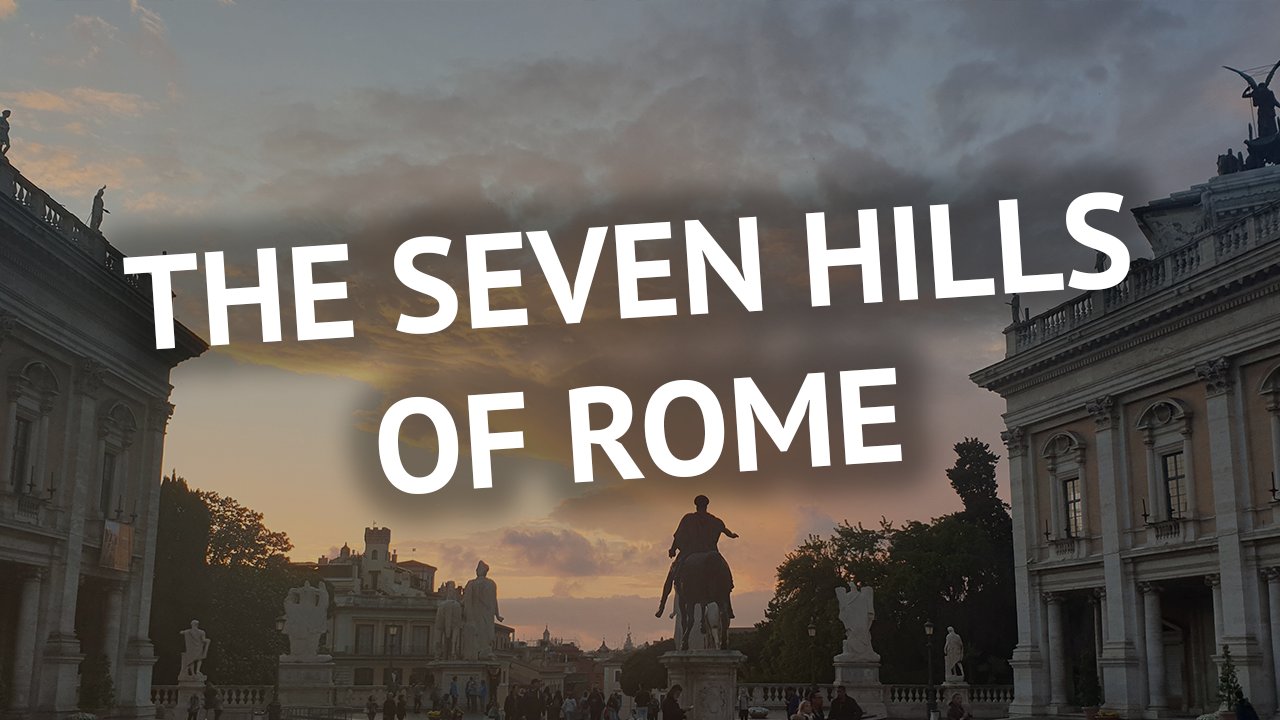The Capitoline Hill is one of the seven hills on which Rome was built. The hill was seen as the epicenter of the Roman Empire. Because of this, the Romans named the hill caput mundi, meaning ‘head of the world’ in Latin. The name derives from a myth that a head was discovered when workers were laying the foundations for the temple of Jupiter Optimus Maximus, and priests declared it a sign that the hill would serve as the head of the world. There may be some truth to the myth: archaeological evidence indicates that the hills of Rome were already inhabited during 10th and 9th centuries BCE, long before the temple was constructed in 509 BCE. Therefore, it is possible that the builders stumbled upon the remains of an early burial.
The hill housed a great number of the most important temples. First and foremost, the temple of Jupiter Optimus Maximus (or ‘the Temple of Capitoline Jupiter’), the remains of which can still be seen from the Capitoline Museums. A slightly smaller temple dedicated Juno Moneta stood nearby. It was linked to a mint that produced Roman coins, or moneta in Latin. The Romans built several other temples to worship the gods on the slopes of the hill, including the Temple of Saturnus, built in 498 BCE, and the temple of Concordia, built in 121 BCE. Beneath the hill, the economic, political, and social life of Rome took place on the Forum Romanum. Julius Caesar extended the Forum Romanum in 54 – 58 CE, by constructing the Forum of Caesar at the foot of the Capitoline hill.
Unfortunately, due to the construction of the enormous monument honoring Vittorio Emanuele II beginning in 1885, today very little of the ancient history of the Capitoline Hill is visible. Vittorio Emanuele II is regarded as the father of Italy due to the significant role he played in the country’s unification when Rome was declared as the capital. Large portions of the fora were demolished to create space for the construction of the monument.
The Campidoglio is the famous piazza located at the top of Capitoline Hill. The location retained political significance during the Middle Ages, as evidenced by the construction of the Palazzo Senatorio in the 12th century. Between 1534 –1538, Michelangelo was commissioned to redesign the piazza, alter the facades of the existing Palazzo Senatorio and the Palazzo dei Conservatori, and design the Palazzo Nuovo, creating a bold trapezoidal shape for the piazza.
In the center of the piazza stands a replica of the statue of Marcus Aurelius (the original was moved inside the Capitoline Museums). During the Renaissance, the statue was believed to represent Constantine, the first Christian emperor of Rome. It is due to this error that the statue survived for so long. Nearly all known bronze statues and architectural elements (including the clamps that held the stones of the Colosseum together and the dome of the Pantheon, which was originally covered with a layer of bronze) were melted down and reused for new purposes such as cannonballs or decorative elements for the city’s many new churches. Due to the importance of Constantine to the Christian legitimacy of Rome, the Marcus Aurelius statue survived and can now be admired in the Capitoline Museums.
BIBLIOGRAPHY
- Adriano La Regina, Guida archeologica di Roma, (3rd edition), Mondadori Electa S.p.A.: Milan, 2018.
- Fentress, ‘Museum Review: Around the Temple: The New Galleries of the Capitoline Museum’, American Journal of Archaeology, vol. 111 (2), p. 365-369, 2007.
- Fehl, ‘The Placement of the Equestrian Statue of Marcus Aurelius in the Middle Ages’, Journal of the Warburg and Courtauld Institutes, vol. 37, p. 362-367, 1974.
- Platner, ‘Capitolinus Mons’, A Topographical Dictionary of Ancient Rome, London: Oxford University Press, 1929.
- Platner, ‘Temple of Concord’, A Topographical Dictionary of Ancient Rome, London: Oxford University Press, 1929.
- Platner, ‘Juno Moneta’, A Topographical Dictionary of Ancient Rome, London: Oxford University Press, 1929.
- Statua Equestre di Marco Aurelio, (2017), Musei Capitolini, https://www.museicapitolini.org/it/percorsi/percorsi_per_sale/museo_del_palazzo_dei_conservatori/esedra_di_marco_aurelio/statua_equestre_di_marco_aurelio
Capitolinus Mons: the smallest of the hills of Rome, with a length of about 460 metres and an average width of 180, lying between the forum and the campus Martius and extending in a general north-east — south-west direction.
Read more:
It was surrounded by steep cliffs on all sides except the south-east, where it was accessible from the forum valley, and was composed of three distinct parts, the elevations at the north and south p96 ends and the depression between them. The present height of the north summit at the church of S. Maria in Aracoeli is 39 metres above the mean level of the Tiber; that of the south summit, the Via di Monte Tarpeo, 38 metres; and that of the Piazza del Campidoglio, 30 metres.
In the earliest period the north elevation seems to have belonged to the Sabine settlement on the Quirinal. Possibly the south portion came into possession of the Palatine Romans, but at any rate the whole hill became part of the enlarged city at the stage known as the City of the Four Regions, when the Romans and Sabines had united, although it was not included in one of the regions themselves. This seems to have indicated that it belonged to the community as a whole. Originally the north summit — and presumably the south — was fortified in the usual way by escarpments and breastwork where the cliff was steep, and elsewhere by tufa walls, some traces of which have been found When the Palatine and Sabine settlements were united, the wall of the enlarged city included the whole hill and ran along its north-east side, the line of the later so‑called Murus Servii Tullii (q.v.) Traces of the latter have been found at some points.
On the north elevation was the Arx (q.v.), or citadel, and on the south Tarquin established the worship of the triad of great gods — Jupiter, Juno and Minerva — thereby marking this point as the religious centre of the community (Gilb. II.448‑456). To it was given the name Capitolium (caput, capitalis), which the Roman antiquarians explained by a story that in digging for the foundations of the great temple of Jupiter, the workmen found a human skull of great size which was regarded as prophetic of the future greatness of the city (Reference Latin Library Liv. I.55); Varro, LL V.41). Capitolium, therefore, was originally the proper designation of this part of the hill, and continued to be so used (Cic. pro Scaur. 47; Varro, LL V.149; Verg. Aen. IX.448; Hor. Carm. III.30.8; (Latin Library: Liv. III.18.10). The official designation of the hill was Arx et Capitolium (Liv. II.7.10; III.68.7; Liv. III.18.1: arce Capitolioque; III.19.7: in arce in Capitolio; VI.20.13: arce aut Capitolio; in arce aut in Capitolio) or Capitolium et Arx with variations (Cic. pro Rab. 35; Liv. I.33.2; VI.11.4; XXXVIII.51.8), which indicated its double nature and continued in use down to the end of the republic, although the increasing importance of the Capitolium and the decreasing necessity for a citadel led to the gradual application of the term Capitolium to the entire hill (CIL I2 p191, 6, 198.18; Cic. pro Font. 30; Liv. III.19.12; Val. Max. I.1.11; Serv. Aen. I.720; Suet. p97 Tib. 3; Gell. XVII.21.24; and freq. See also Acta Lud. Saec. Aug. CIL VI.32323, 18, 79, 81, 103, 119, 148). On the other hand, the word Capitolium was also employed to designate simply the temple of Jupiter itself, as the most significant part of the whole (Cic. de Orat. III.180; Vitr. III.3. 5; Plin. NH VII.182; and freq.). An interesting discovery was made in Corinth in 1927 at the north end of the Lechaian road. Several marble blocks were found, dressed to represent native rock, and four of them were inscribed in Latin (1) Capitolinus, (2) Aventinus Mons, (3) Collis Viminalis, (4) [Es]cu[i]linus Mo[ns] (YW 1926, 190). The adjective Capitolinus was of course derived from the noun, and mons Capitolinus became a common name for the whole hill (ad Her. IV.43; Fest. 322; Solin. I.12; IV.13; Flor. Ep. I Oros. II.19.8; (Reference Latin Library Manil. IV.28;) Vib. Seq. geogr. min. 157 (Riese)); collis Capitolinus (Liv. I.12.1; Mart. XII.21.6; Arnob. Nat. IV.3; August. de civ. II.22; III.8, 12; IV.23). The depression between the two summits was called or the latter name being explained by the story that Romulus welcomed here the refugees from other towns (Liv. I.8). The precipitous cliff at the south-west corner of the Capitolium, from which criminals convicted of capital offences were hurled, was known from early times as saxum Tarpeium (Varro, LL V.41) or rupes Tarpeia and both the whole hill and its southern part were called, but the statement of the Roman antiquarians that this was the original name of the hill is false. It was also called Saturnius: cf. Varro, LL V.42 (antiquum oppidum in hoc fuisse Saturnia scribitur); Fest. 322; Solin. I.13.
The principal approach to both summits of this hill was the Cilvus Capitolinus (q.v.) originally a path leading from the forum to the depression between the summits, where it divided; but the erection of the Tabularium (q.v.) at the end of the republic, and of the mediaeval buildings, destroyed all traces of earlier conditions on the ridge between the elevations. There were also two flights of steps, the Centum Gradus and (perhaps) the Gradus Monetae (qq.v), which led to the top of the hill from the forum side.
The Capitolium proper, or south summit, was occupied by the most famous of all Roman temples, that of luppiter Optimus Maxiumus Capitolinus (q.v.), and the Area Capitolina (q.v.) or space in which this temple and others stood; while on the north summit were the Arx and temple of luno Moneta (q.v.). During the first centuries of the republic, private dwellings were erected to some extent on the hill, for in the year 390 B.C. there was a guild of those who dwelt in Capitolio atque arce (reference Latin Library Liv. V.50); and after the treason of Manlius, a law was passed which forbade any patrician to live on either summit (Latin Library (Liv. VI.20). In spite of such prohibitions, the gradual destruction of the fortifications and the demands of a rapidly increasing population led to continual encroachments upon this quasi-sacred hill. In 93 B.C. a considerable tract, which had belonged to the priests, was sold and came into private possession (Oros. V.18; cf. also Cic. pro Mil. 64). By the middle of the first century the whole hill, with the exception of the area Capitolina, the actual sites of the temples, and the steepest parts of the slopes, was occupied by private houses Remains of these houses have been found on the Arx near the church of S. Maria in Aracoeli, and at the foot of the stairway leading from the Piazza d’ Aracoeli to the church (NS 1888, 497; 1889, 68; Mitt. 1889, 255; BC 1873, 111‑122, 143‑146; 1888, 331; see also Acciaresi, Giuseppe Sacconi (Rome 1911), p40, fig. 45; Capitolium II.270‑275; cf. Fea, Fasti 114).
For the Capitoline in general, see Jord. I.2.1‑154; Gilb. I.2424‑57; RE III.1531‑1538; E. Rodocanachi, Le Capitole romain antique et moderne, Paris, 1904, and the English translation by Frederick Lawton, The Roman Capitol in Ancient and Modern Times, London 1906; Hülsen in Festschrift für H. Kiepert, Berlin 1898, 207‑222; and Bilder aus der Geschichte des Kapitols, Rome, 1899; Rueter, Das Kapitol, Progr. Halberstadt, 1898).
This content is brought to you by The American Institute for Roman Culture, a 501(C)3 US Non-Profit Organization.
Please support our mission to aid learning and understanding of ancient Rome through free-to-access content by donating today.
Cite This Page
Cite this page as: Darius Arya, The American Institute for Roman Culture, “Capitolinus Mons (Capitoline Hill)” Ancient Rome Live. Last modified 07/03/2020. https://ancientromelive.org/capitolinus-mons-capitoline-hill/
License
Created by The American Institute of Roman Culture, published on 07/03/2020 under the following license: Creative Commons: Attribution-NonCommercial-ShareAlike. This license lets others remix, tweak, and build upon this content non-commercially, as long as they credit the author and license their new creations under the identical terms. Please note that content linked from this page may have different licensing terms.




